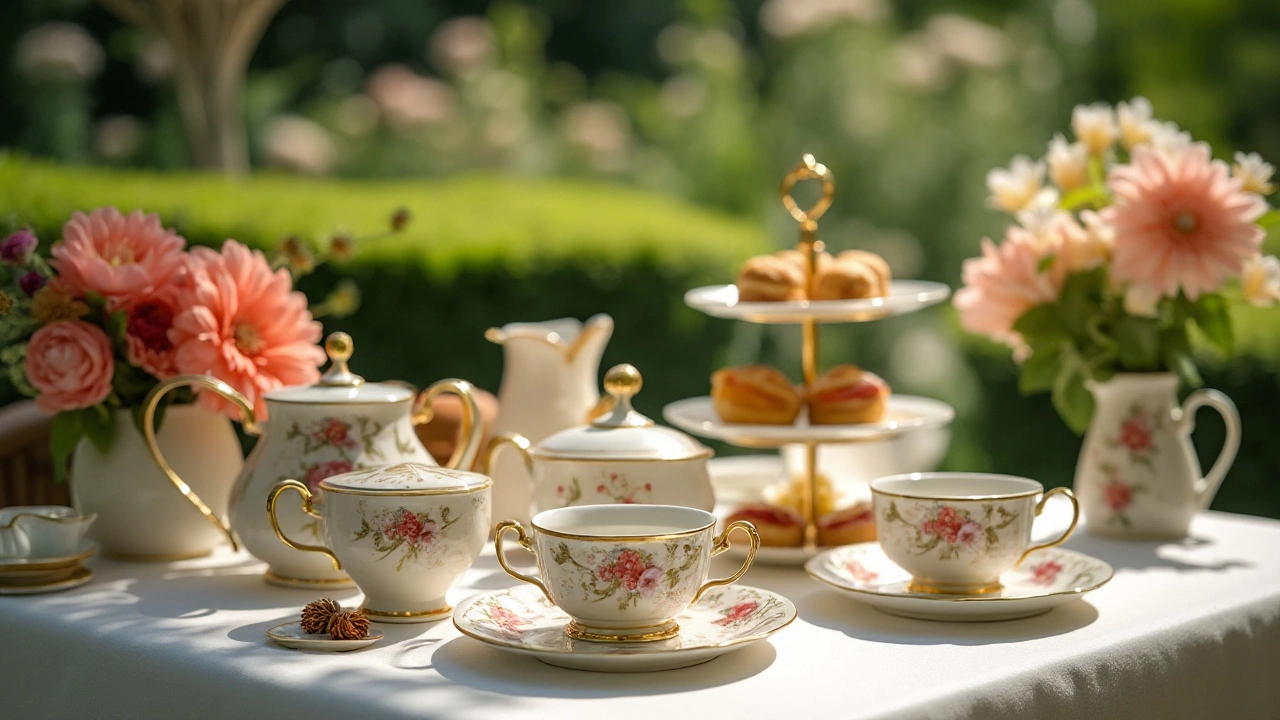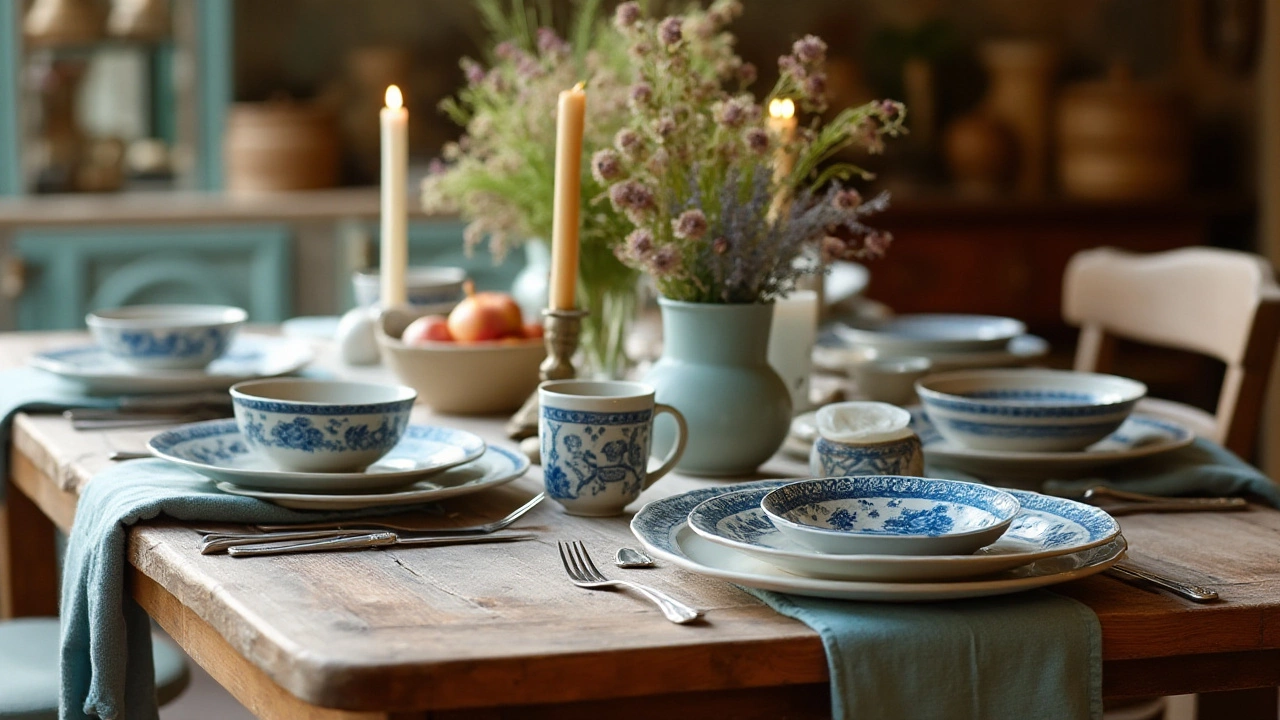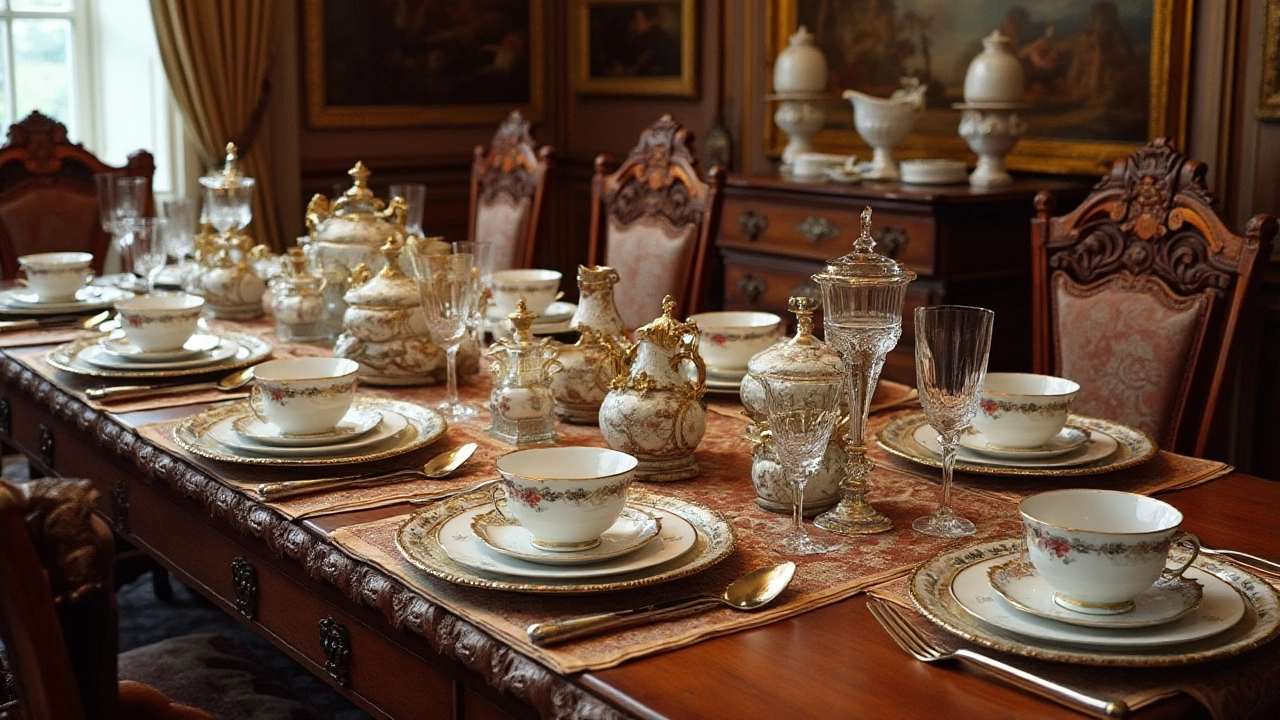Understanding Dinnerware: Names and Functions of Cups, Saucers, and Plates
 Jan, 15 2025
Jan, 15 2025
When setting a table, the terms cups, saucers, and plates seem straightforward, yet they hold more significance than one might initially perceive. Commonly referred to as dinnerware, these items are more than mere vessels for food and drink. They are reflections of history, culture, and the art of dining.
Ranging from intricate bone china to everyday stoneware, the materials and styles of these pieces have evolved over time, adapting to changing tastes and technologies. But no matter their design, each cup, saucer, and plate retains its unique role. Whether for a casual breakfast or a formal dinner, understanding the functions and history of these items can elevate the entire dining experience.
- The Evolution of Dinnerware
- Understanding the Components
- Different Types of Cups
- Saucers: Functionality and Style
- Plates: Types and Uses
The Evolution of Dinnerware
Since the dawn of civilization, humans have shown a penchant for creating and using vessels for their food and drink needs. The journey of dinnerware is a fascinating tale marked by changes in culture, technology, and artistry. Archaeological findings suggest that the earliest plates were made of natural materials such as leaves or wood. As human society advanced, clay made its entry, ushering in the era of pottery. Over time, these humble beginnings gave rise to sophisticated ceramic techniques.
During the Tang Dynasty (618-907 AD), China emerged as the pioneering region in the production of fine porcelain, setting the gold standard for plates and other dinnerware. The secrets of porcelain making were closely guarded, and it wasn’t until the 18th century that Europeans succeeded in creating their own quality examples, thanks to the efforts of alchemists like Johann Friedrich Böttger. This breakthrough sparked the establishment of many famous European manufactures such as Meissen and Sèvres.
The Victorian Era marked another significant shift with the industrial revolution, as dinnerware became more accessible to the masses. The British middle class, in particular, developed a keen interest in tea, prompting the design evolution of the teacup and its matching saucer. These items became not just vessels, but symbols of social status and taste. The 20th century saw the introduction of varied materials like stainless steel, melamine, and even biodegradable options to cater to different needs and preferences. Innovation and sustainability now drive the market, with contemporary designs often reflecting a blend of tradition and modernity.
"The history of tableware is a window into the varied tapestry of human society." - The British Museum
The evolution continues as designers and manufacturers experiment with technologies such as 3D printing and smart dinnerware, capable of monitoring nutritional content. It is clear that the development of dinnerware is inseparably linked to human creativity and adaptability. Whether extravagant or minimalist, today's styles offer an array of choices that add functionality and beauty to dining experiences around the world.
Understanding the Components
Dinnerware, often taken for granted, is a fascinating subject when you start delving into the specifics. When we talk about cups, saucers, and plates, we're discussing items with distinct functions and histories. Each of these pieces has undergone transformations over the years, reflecting changes in technology and culture. Knowing the story behind these objects brings an appreciation for their design and utility.
Cups are undoubtedly one of the most versatile elements in this trio. Whether you're sipping tea, coffee, or a hot chocolate, the right cup can affect your overall drinking experience. The perfect cup retains heat, offers comfort through its handle, and is artistically pleasing. Different beverages have inspired the creation of various cup styles, from espresso cups to oversized mugs for those who love their drinks supersized.
Cup Varieties and Their Uses
The history of cups can be traced back to ancient civilizations. Early cups were made from materials such as wood and clay, but over the centuries, developments in materials like porcelain and glass have revolutionized how we enjoy our beverages. Today, cups come in a plethora of shapes and sizes, each catering to a specific drink type. For instance, the iconic teacup, often part of elegant tea sets, is designed with a wide bowl to enhance both aroma and drinking experience. Alternatively, the coffee cup usually features a narrower rim to maintain temperature and allow for the perfect amount of aroma release. Such designs highlight the importance of function in cup design.
Let's not forget the contemporary iterations, like travel mugs made with insulating technology to keep drinks hot or cold for hours, reflecting our love for convenience. In a nod to environmental friendliness, we now see cups crafted from recycled materials, playing a part in reducing our ecological footprint. An interesting touch is the inclusion of artwork or personalized designs, making cups not just functional but also personal statements. As Harold McGee once said, "A cup is no longer just a cup, it is a vessel for ideas."
The Ever-Important Saucer
Then, we have the saucers, which might seem secondary but serve an essential purpose. They initially evolved as a practical solution to prevent spills and protect tabletops from heat damage. In traditional settings, saucers complement cups by providing a base to hold a small sweet treat or a spoon. In more formal dining settings, saucers help prevent drips, emphasizing etiquette. The dawn of the 18th century saw saucers become elaborate pieces, bearing intricate patterns to match the artistic craftsmanship of the era. This dual purpose of beauty and utility is what makes saucers intriguing elements of the dinnerware collection.
Plates – More Than Just a Base
Plates are arguably the pinnacle of the dinnerware realm, used in nearly every meal across almost all cuisines. They come in a staggering number of variations, each serving specific culinary functions. Whether it's a dinner plate, a salad plate, or a dessert plate, each has a specific diameter and depth to accommodate the intended fare. Dinner plates, typically the largest, serve as the canvas for main courses. Salad plates, often smaller, provide a platform for appetizers or side dishes, and dessert plates accommodate sweets elegantly. A notable fact: the iconic modern plate design featuring a wide rim was first conceptualized to accommodate plated service, a shift that took place during the 19th century. This evolution has dovetailed with changing culinary arts, shaping how food is presented and enjoyed.
Plates have diversified into deeper realms such as soup plates, charging plates, and the artistic realm of hand-painted ceramics, each showcasing craftsmanship and facilitating the art of cuisine. The choice of material is equally varied, from everyday melamine to fine porcelain reserved for the most sophisticated settings. This versatility, alongside practical considerations like durability and ease of cleaning, shapes our collection of plates, making them indispensable in the kitchen.

Different Types of Cups
The world of cups is rich and varied, reflecting a diversity that mirrors the cultures and beverages they are designed for. Each type of cup has been innovatively crafted to enhance a particular drinking experience, whether it involves sipping on a hot brew or enjoying a chilled delight. In the realm of kitchenware, cups range in design and function, each offering a unique take on tradition and modernity. From the elegant porcelain teacup that dominates afternoon high teas to the sturdier mugs providing warmth during chilly winters, the options are extensive. These cups are not just about utility; they are about enhancing the sensory experience of savoring a drink. Let’s explore some well-known types and what makes them distinct: teacups, coffee mugs, espresso cups, and more. Such variety allows for a personalized connection to our everyday rituals and social gatherings.
Teacups
Teacups are often the most delicate members of the cup family. They are typically made from fine porcelain or bone china, reflecting a long tradition connected with the practice of tea drinking itself. The size is generally small, as were their predecessors in ancient China, designed to cool tea quickly before sipping. Modern teacups often feature a subtly flared lip and a handle, encouraging an elegant hold. These cups possess a timeless aesthetic appeal, which makes them a cherished addition to any tea enthusiast's collection. Whether part of an elaborate tea set or a standalone piece, they serve a purpose beyond their beauty, fostering an atmosphere of tranquility and reflective conversation. Oscar Wilde, a known tea lover, once noted, "Tea teaches us how to be idle and devoted."
Coffee Mugs
Coffee mugs, on the other hand, cater to those seeking a heartier serving size. Typically fashioned from stoneware, ceramic, or glass, these mugs are built to provide durability and insulation. The American diner culture popularized them as robust vessels capable of holding what is often a significant part of many morning routines. Unlike their slimmer relatives, mugs boast a thicker wall to keep your brew warm for longer periods. The use of a mug infers a casual, comforting vibe, making them perfect for home use or workplaces. An interesting tidbit is that coffee mugs often serve as blank canvases for personalization, a trend dating back decades.
Espresso Cups and Others
Then, stepping into the role of the alchemist’s flask, espresso cups, or demitasse cups, are specifically designed for a concentrated coffee experience. These cups have a smaller capacity to accommodate Italy’s beloved espresso, offering just enough space for the golden crema to form its cap on the stark, dark liquid. Often crafted with thicker walls, they retain the warmth and encapsulate the richness of the brew. In terms of design, they are understated yet crucial to extracting the essence of coffee. For something traditional but less intense, there's the Irish coffee glassware, perfectly shaped for the delightful blend of whiskey and coffee, topped with cream. There are also specialized cups such as the Turkish coffee cup and the modern travel mug, each designed to meet varied lifestyle needs.
The intersection of cultural significance and practicality seen in cups is a testament to how fundamental they are to human expression and tradition in dinnerware. So next time you sip, remember that your choice of cup is not merely about function—it tells a story, connects past with present, and transforms the simple act of drinking into an experience worth savoring.
Saucers: Functionality and Style
The humble saucer, often overlooked, plays a significant role in the realm of dinnerware. At first glance, one might assume a saucer merely serves as a resting place for a cup, but its functionality extends beyond this superficial assumption. The primary role of a saucer is indeed to catch drips from a cup, preventing them from staining delicate tablecloths or table surfaces. This preventive measure not only protects furniture but also maintains the neatness of the dining setup.
Beyond practicality, saucers add an element of style to dining experiences. Historically, saucers have been crafted from exquisite materials, including fine porcelain and intricately painted ceramics. These materials reflect cultural art forms, adding character and aesthetic appeal to mealtimes. It is worth noting that in the 17th century, a time when tea drinking became fashionable in Europe, saucers were often larger and used as direct drinking vessels. This tradition, while largely lost to time, illustrates the ever-evolving nature of dinnerware.
"Saucers are more than simple utilitarian tools; they are canvases of history and beauty," remarked Julia Davis, author of 'Elegant Etiquette: The Art of Fine Dining.'
Today, saucers come in various styles, often designed to match their corresponding cups. Patterns may be delicate floral designs or bold contemporary prints, each choice contributing to the ambience of an event or daily use. Interestingly, in some cultures, like those in the Middle East, saucers sometimes double as small plates for serving sweets or appetizers, demonstrating their versatility.
The choice of saucer design can influence the perception of a dining experience. Traditional white saucers often lend a clean, timeless look, suitable for formal occasions. In contrast, vibrantly colored or uniquely shaped saucers can inject personality and create a more casual atmosphere. For many, collecting saucers from different regions and eras has become a cherished hobby, transforming their cupboards into galleries of art and history.

Plates: Types and Uses
Plates are a central part of dining experiences across the globe, serving as the canvas on which culinary creations are displayed. There are a myriad of plate types, each designed for a specific purpose, contributing both functionally and aesthetically to the dining table. While the average household might prioritize practicality, emphasizing durability and ease of cleaning, those with an eye for design might collect an assortment of plates, each piece adding a touch of elegance to a meal.Ceramic plates have long been favored for their versatility. They are resistant to heat, can handle a variety of foods, and are available in countless shapes and patterns. Ceramic encompasses material types like stoneware and earthenware; the former being known for durability, while earthenware is appreciated for its rustic appeal. Meanwhile, in more formal settings, porcelain plates are preferred. Characterized by their delicate and pristine finish, porcelain plates require careful handling but reward with their unrivaled elegance.
Another type, melamine plates, often finds its place in picnics or outdoor dining due to its resilience against breaking. These plates might not contain the elegance of porcelain, but they highlight the importance of practicality in certain settings. Glass plates, while less common, add a unique, modern touch to dining settings. They capture the eye with their appealing transparency and are often used to frame visually striking dishes. The choice is endless, and each type has its own unique contribution to dining aesthetics and utility.
Let's dive deeper into some specific types, starting with dinner plates. They are usually around 10 to 12 inches in diameter and can host a variety of meals. Whether it’s a luxurious spread of lasagna or a casual steak with vegetables, dinner plates provide the space needed to prevent food overflow. Another popular variant, the salad plate, is typically used for serving starters or side salads, measuring about 7 to 9 inches. The choice of using a separate plate not only supports portion control but also ensures varied flavors remain distinct.Bread plates are also a classic staple in formal dining, and they are often seen partnered with butter knives at the top left of the main plate setting. These plates tend to be smaller, usually about 6 inches, catering specifically for bread and rolls during meals.
Lastly, the dessert plate, known for its smaller size, adds a touch of sweetness to the end of a meal. Party platters and charger plates add to the array, serving specialized purposes, be it for communal eating or to accentuate the overall presentation of a meal. The nuances of each plate type can transform the simple act of eating into a full sensory experience. As designer Deborah Needleman once noted, "Plates bring a soul to the table, they bear the weight of our meals and reflect the love and care invested in each dish."
Plates bring a soul to the table, they bear the weight of our meals and reflect the love and care invested in each dish.
A closer look at serving sizes and combinations can reveal interesting cultural patterns and dining habits, tailored to different geographic regions and cuisines, making plates more than mere kitchenware — an integral part of savoring every meal.